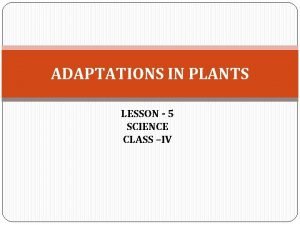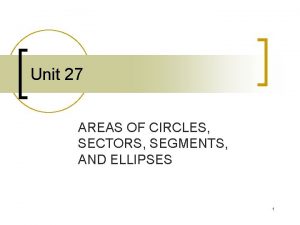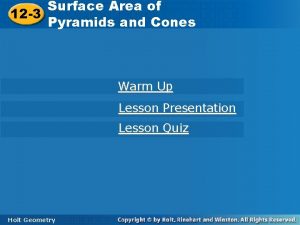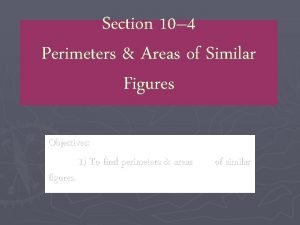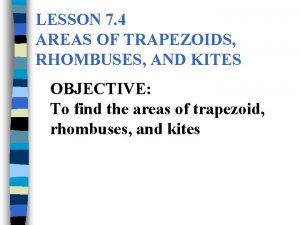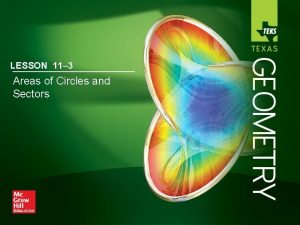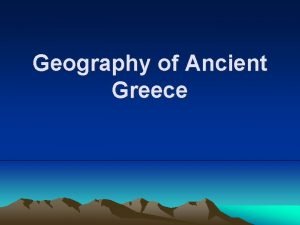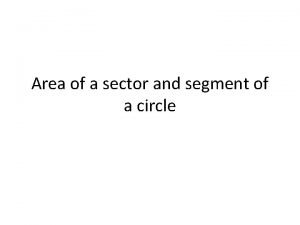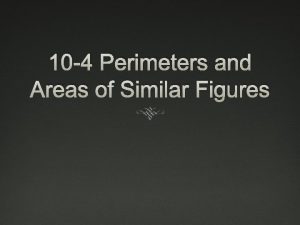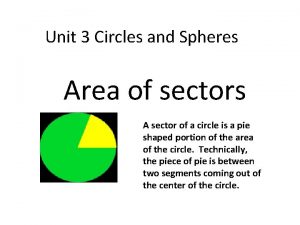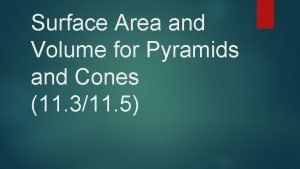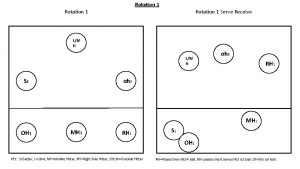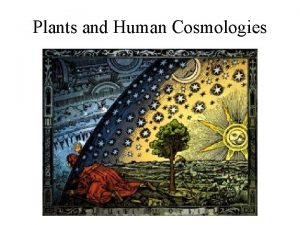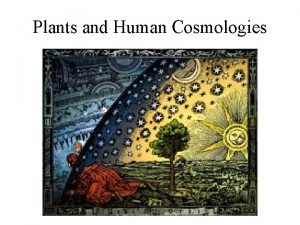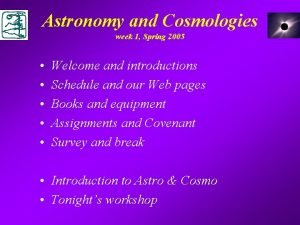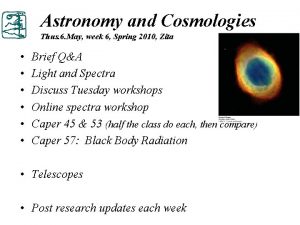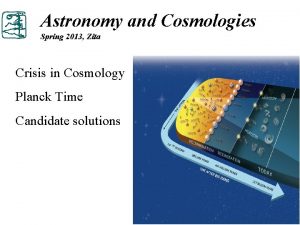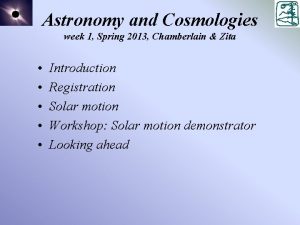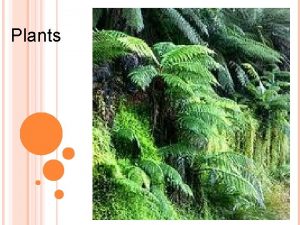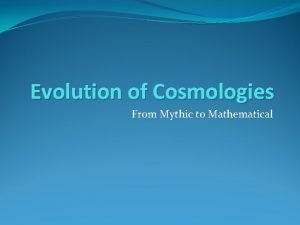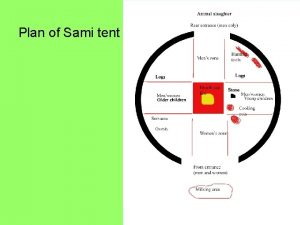Plants and Human Cosmologies Areas where special plants




















































- Slides: 52

Plants and Human Cosmologies

Areas where special plants are used to enter another world

Marijuana – Cannabis sativa

Ancient Use of Cannabis • 2000 BCE – Writings of Shen Nung mention Cannabis as an important plant for the treatment of various illnesses including beri-beri, malaria, and forgetfulness. He also described the plant as freeing the psyche: “If taken over a long term, it makes one communicate with spirits and lighten one’s body. ”

Ancient Use of Cannabis • Writers in China warned that Cannabis was a “liberator of sin. ” ~ 2000 BCE • By 1500 BCE the plant known as “ma” was reported as useful for shamanistic purposes • 2 nd Century AD Chinese physicians mixed it with wine and used it as an anaesthetic during surgery

Ancient Use of Cannabis • 500 – 300 BCE - ancient Scythians in the Near East used Cannabis as a psychotropic drug • Herodotus reported that Scythians delighted in vapor baths scented by Cannabis seeds placed on heated stones • 4 th Century BCE - Cannabis seeds discovered with skeleton in tomb in Jerusalem

Al-Hasan ibn al-Sabbah • By 1090 had established fortress on trade routes to China and India – ruled army of thieves whom he supplied with hashish and women in return for their loyalty

Introduction to Europe • Europeans were introduced to Cannabis as a psychoactive plant by Napoleon’s soldiers after the conquest of Egypt in 1800. They began by consuming resin of Cannabis flowers and leaves (hashish). At first the resin was used to treat mentally ill, but soon it was used recreationally too. By 1844 so many fashionable Parisians were enjoying their visions from use of hashish that they formed a club, Le Club des Haschins, and held monthly meetings at the Hotel Pimodan on the Ile Saint-Louis.

The Hotel Pimodan

Modern Water Pipe and Hashish

Bob Marley and the Wailers Album Cover - 1973

Cannabis smoker – Southeast Asia


Cannabis sativa and C. indica

Cannabis sativa and C. indica

Cannabis sativa x indica hybrid

High tech Cannabis growing in the Netherlands

UK Police Bust of High-Tech Growth

World laws on possession of small amounts of recreational cannabis q Legal or essentially legal q Decriminalized q Illegal but unenforced q Illegal

Coca plant – Erythroxylum coca

Growing coca plant

Use of Coca Plant • Coca was domesticated in Pre-Columbian times - it may have been domesticated as long ago as 7000 years ago • The first Spanish explorers reported the natives of the Andes chewing coca leaves with mineral lime, a substance that helps the mucous membranes of the mouth absorb the alkaloids from the leaves • This practice probably dates back at least 5000 years and is still done today

Clay vessel depicting Coca chewer – from Peru – 400 -600 AD

Medicinal and Dietary Properties of Coca • Chewing coca leaf helps relieve the headache, nausea, and weakness of altitude sickness and helps relieve the general fatigue of travel • Coca leaves also contain an assortment of vitamins and minerals that make a valuable contribution to the often impoverished Andean diet • One hundred grams of coca leaves contains more calcium, iron, phosphorus, vitamin A, vitamin B 2, and vitamin E than called for by the US recommended daily allowance

Coca leaves for sale in market in La Paz, Bolivia

John Styth Pemberton and Coca Cola

Cola acuminata and cola nuts

Advertisement for French “Tonic” Wine made of red bordeaux and coca leaves

Columbia ends spraying of coca plants • http: //www. nytimes. com/2015/05/15/world/ americas/colombia-halts-us-backedspraying-of-illegal-coca-crops. html

Plants for Dyes and Decorations

Woad – Isatis tinctoria

Woad Dyes • Woad produces a substance in its leaves called isatan B which, when exposed to the air, forms the blue compound indigo. • This compound can easily be removed from the leaves by boiling them in water and an alkaline solution, a process used by home dyers today to make indigo today

Woad Dye and Woad Dyed Wool

Woad Body Decoration

Woad dyed British police uniform

Source of Henna – Lawsonia inermis

Henna Dye • Henna, Lawsonia inermis, produces a red-orange dye molecule lawsone. This molecule has an affinity for bonding with protein, and thus has been used to dye skin, hair, fingernails, leather, silk and wool. • Henna body art is made by applying henna paste to the skin: the lawsone in the paste migrates into the outermost layer of the skin and makes a red-brown stain. • Products sold as "black henna" or "neutral henna" are not made from henna, but may be derived from indigo (in the plant Indigofera tinctoria) or Cassia obovata

Henna Preparation • Dried ground, sifted henna leaves are easily worked into a paste that can used to make intricate body art. • Commercially available henna powder is made by drying the henna leaves and milling them to powder, then the powder is sifted. • This powder is mixed with lemon juice, strong tea, or other mildly acidic liquids. Essential oils with high levels of monoterpene alcohols such as tea tree, eucalyptus, cajeput, or lavender will improve skin staining characteristics.

Mehndi – traditional Indian bridal henna art

Modern body art with Henna

Traditional tattoo on resident of Nuka Hiva- late 1700’s

Otzi the Iceman and his tatoos

Candlenut tree – Aleurites moluccana

Traditional Samoan Tattooing • The pigments used in traditional Samoan tattooing comes from the nuts of the candlenut tree Aleurites moluccana (Euphorbiaceae) - called lama in Samoan • The seeds are burned to produce soot which is collected on banana leaves and stored in coconut shells

Candlenut seeds ready to be burned to produce soot

Samoan Tattooing Technique • Tattooing is done by grinding the soot with a mortar and pestle • A serrated comb of pig bone is used to penetrate the skin, and a mallet pounds the comb and pigment into the skin • A towel of bark cloth is used to wipe away the blood

Traditional Samoan tattoo process as done today

Traditional Samoan tattooing tools

Traditional Tattoo Patterns

Traditional Tattoos from Rongiroa

Completed modern version of traditional Samoan tattoo

Tattoo Tradition Spread Around the World
 Areas of special emphasis examples
Areas of special emphasis examples Where do fixed floating plants bear stomata on their leaves
Where do fixed floating plants bear stomata on their leaves Characteristics of non-flowering plants
Characteristics of non-flowering plants What non vascular plants
What non vascular plants Non vascular plants
Non vascular plants C3 plants vs c4 plants
C3 plants vs c4 plants Human needs and human development
Human needs and human development Chapter 8 human needs and human development
Chapter 8 human needs and human development Non human nouns
Non human nouns Human vs non human bones
Human vs non human bones Gni definition ap human geography
Gni definition ap human geography Volume of a frustum of a pyramid
Volume of a frustum of a pyramid 11-3 areas of circles and sectors answer key
11-3 areas of circles and sectors answer key Lesson 10-4 surface area of prisms and cylinders
Lesson 10-4 surface area of prisms and cylinders 12-3 surface area of pyramids and cones
12-3 surface area of pyramids and cones Lesson 10-4 perimeters and areas of similar figures
Lesson 10-4 perimeters and areas of similar figures If abcd is a rectangle and m adb=55 what is the value of x
If abcd is a rectangle and m adb=55 what is the value of x Liaise between kitchen and service areas
Liaise between kitchen and service areas 12-6 surface areas and volumes of spheres
12-6 surface areas and volumes of spheres 12-3 surface areas of pyramids and cones
12-3 surface areas of pyramids and cones 12-2 surface areas of prisms and cylinders
12-2 surface areas of prisms and cylinders 11.3 areas of circles and sectors
11.3 areas of circles and sectors 10-2 areas of trapezoids rhombuses and kites
10-2 areas of trapezoids rhombuses and kites 11-4 areas of regular polygons and composite figures
11-4 areas of regular polygons and composite figures 11-3 areas of circles and sectors answer key
11-3 areas of circles and sectors answer key Lesson 11-1 areas of parallelograms and triangles answers
Lesson 11-1 areas of parallelograms and triangles answers Flood storage areas advantages and disadvantages
Flood storage areas advantages and disadvantages Difference between urban and rural
Difference between urban and rural Area of an arc
Area of an arc Find the area of each rhombus
Find the area of each rhombus Map of sparta greece
Map of sparta greece Clean public areas facilities and equipment
Clean public areas facilities and equipment Food and beverage service areas
Food and beverage service areas Surface area of pyramids and cones
Surface area of pyramids and cones Surface area of a sector
Surface area of a sector Homework 5 surface area of prisms and cylinders
Homework 5 surface area of prisms and cylinders Surface area of pyramids and cones quiz
Surface area of pyramids and cones quiz Developing formulas for circles and regular polygons
Developing formulas for circles and regular polygons 11-2 surface areas of prisms and cylinders
11-2 surface areas of prisms and cylinders Surface area of prisms and cylinders homework answers
Surface area of prisms and cylinders homework answers 10-4 perimeters and areas of similar figures
10-4 perimeters and areas of similar figures Stage body positions
Stage body positions Similar figures
Similar figures Area of regular polygons assignment
Area of regular polygons assignment Formulating objectives examples
Formulating objectives examples A pie shaped portion of the circle
A pie shaped portion of the circle Who are affected by the problem?
Who are affected by the problem? 8. areas and polygons
8. areas and polygons Posterior palatal seal landmarks
Posterior palatal seal landmarks Triangles and quadrilaterals
Triangles and quadrilaterals Surface area of pyramids and cones
Surface area of pyramids and cones Volleyball zones
Volleyball zones Lesson 9 arc length and areas of sectors
Lesson 9 arc length and areas of sectors

